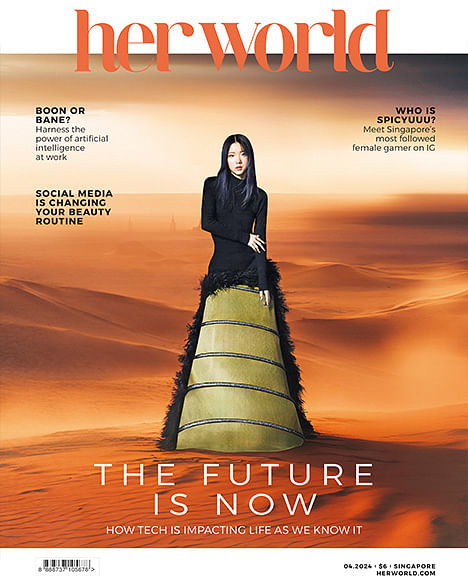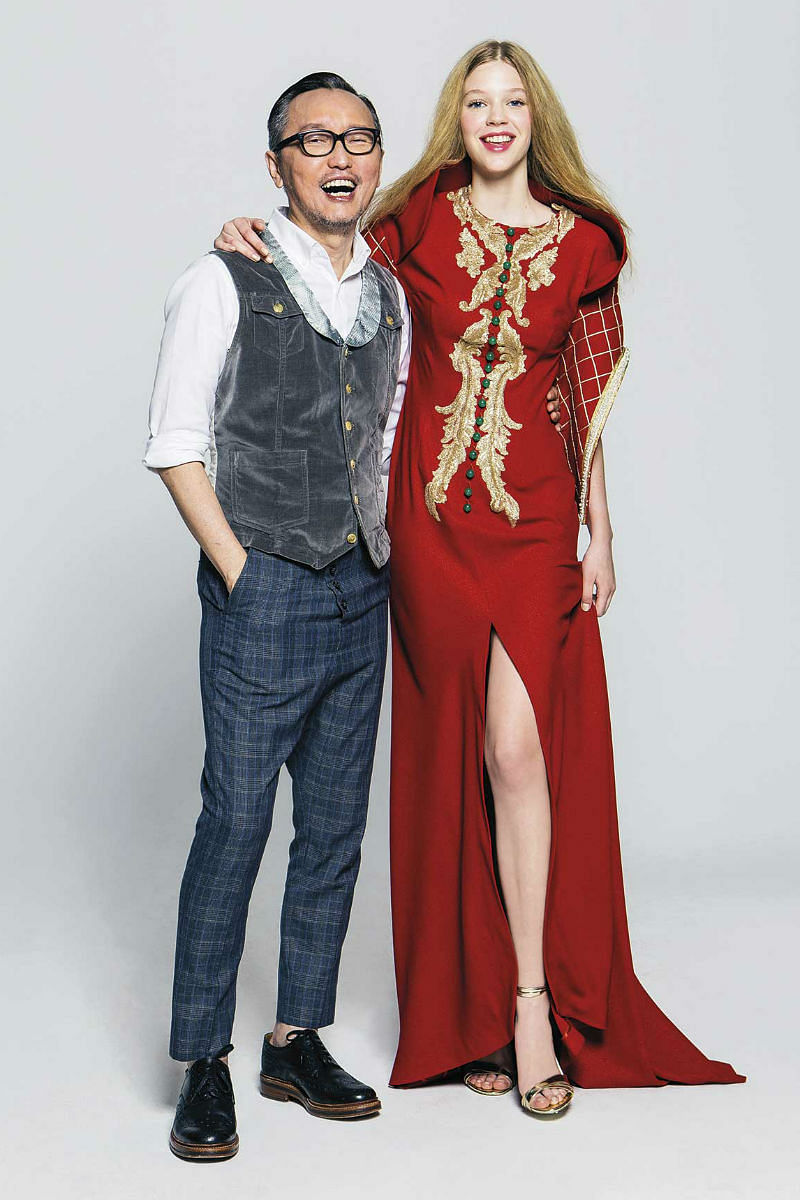
Photo: Zaphs Zhang
For Singapore Fashion Week 2017, Lai Chan showed a 24-piece collection of gowns (this one above is one of them), dresses, and separates for the well-travelled Singapore woman who embraces diversity and different cultures. Items are available to order in your size and specifications. This gown here is designed with an exaggerated cheongsam-inspired collar made to resemble a stole.
The 13th of 15 kids started designing cheongsams for his mum in the early ’80s. By Lai Chan’s second year at Ngee Ann Polytechnic (where he majored in building maintenance management), he already had customers for his cheongsams, evening gowns, cocktail dresses and bridal gowns.
After completing his national service, he opened The Dress Shop at Singapore Shopping Centre while waiting for the spot he wanted at Liang Court. The six years at the latter in a two-unit space near the entrance of the mall were great times. That period, the mid-’80s, was the peak of Japanese fashion and Japan’s economy, and he had many Japanese customers. Apparently, there were even Japanese actresses who wore his dresses to their year-end awards shows.
In 1991, he moved to Raffles Hotel Arcade, where he spent 25 years. It was there that The Dress Shop became Laichan, the label and the store that sold more than cheongsams. Now, at Paragon, some of his customers are from the country the cheongsam originated from – China.
After a strong showing at Singapore Fashion Week 2017, where he showcased his other talents – cheongsam-inspired, made-to-order separates and evening wear – Lai Chan tells us why his mission to create modern cheongsams, which he’s been committed to for the last 30 years, will keep going.
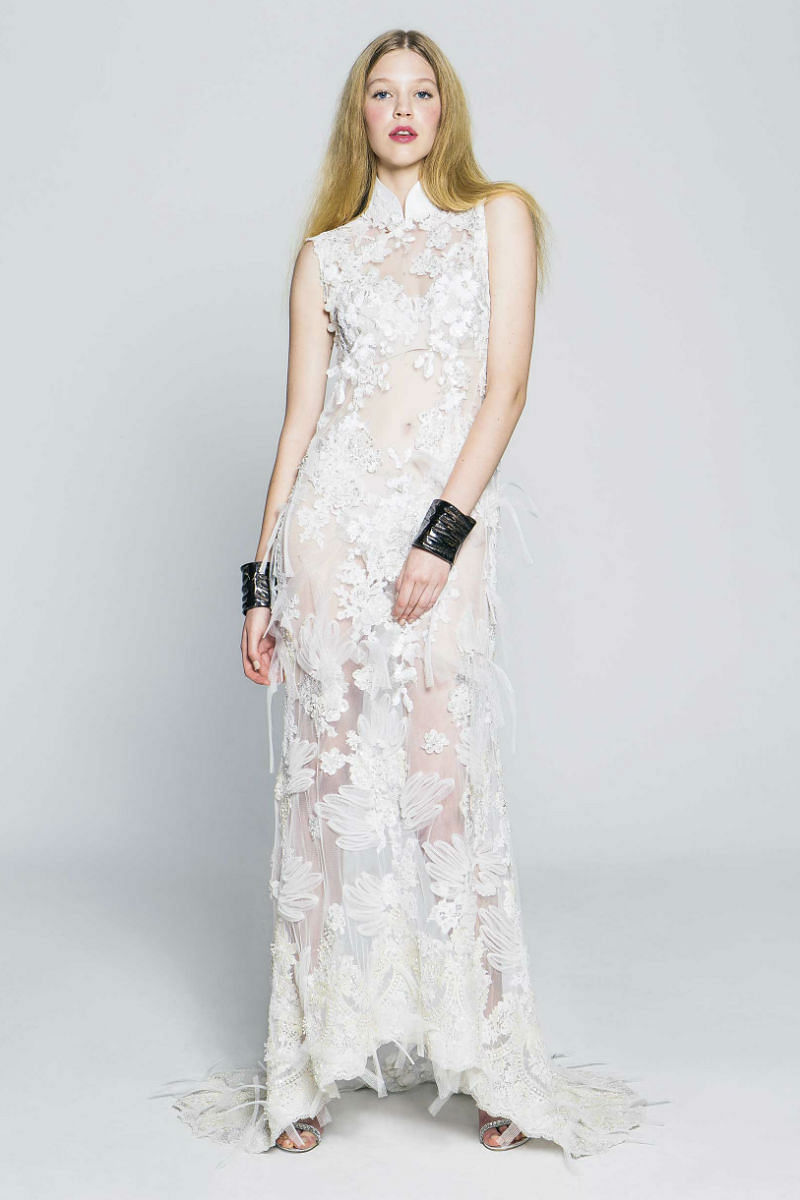
Photo: Zaphs Zhang
This cheongsam was hand-sewn, hand-embroidered, and crafted from scratch using a netting fabric as the base material.
He designs cheongsams because he wants to help preserve our roots
“Of course I don’t think everyone should be wearing cheongsams, but while we strike out, explore, and discover more styles, we shouldn’t lose our roots. I am interested in cheongsams because if I don’t try to develop something that is contemporary, practical and adaptable for the culture now, it will eventually be just a thing of the past, seen only in museums or worn only on special occasions. I thought to myself that if the cheongsam isn’t made more accessible and contemporary, then young people will wear it even less, and in a generation or two, it will completely disappear. Even as we’re better exposed to other cultures through our travels and the Internet, I think it is very important to not forget where we came from.
But while making cheongsams contemporary is important, I don’t think they should be so deconstructed that they become unrecognisable. To me, there should be a certain balance. There is no point in breaking every rule. If you are going to cook nasi lemak with no rice, chilli, or coconut, then it’s not nasi lemak. For cheongsams, you can explore and break certain rules, but at the same time you must stick to some basic discipline.”
Cheongsams are the sexiest
“Nothing beats wearing a cheongsam at a special event. It is quite iconic. It can be very simple, yet very powerful in terms of commanding attention. It’s just a dress, but when you put it on, you’ll stand out, especially in a crowd of people wearing evening gowns. There is just something about it; the curves are more dangerous than, say, a sexy evening gown. A cheongsam has a mysterious allure – that’s how I feel about it. A Versace dress may be very sexy, but a cheongsam which doesn’t show as much is more alluring. That’s probably why a lot of Westerners are taken by its exoticism.”
ALSO READ: MEET LOCAL DESIGNER LAI CHAN WHO’S OPENING SINGAPORE FASHION WEEK
His cheongsams are bias-cut to fit the body better and be more practical for everyday wear
“I learnt the traditional way of making cheongsams from my late Shanghai-trained shifu, but I break the rules. My cheongsams are different because I cut my fabric on the bias – a technique usually applied to Western fashion, not cheongsams. I drape and cut the fabric diagonally to ensure the fabric sculpts a woman’s silhouette softly instead of staying stiff.
A subtler, softer silhouette is more sensual and appealing than a hard and sexy one – hard lines are ageing. When fabric is cut on the bias, it is slightly ‘stretchier’ and drapes better. It follows your curves and moulds to your body when you walk or sit, or when you gain or lose a little weight. Traditional cheongsams create lines around the hips when you are seated, but this won’t happen with my bias-cut ones. I think that makes them very contemporary.
When I first introduced the bias-cut to my team, my shifu refused to do it because it was so different from what he had been taught – they even used to starch the fabric so the cheongsam would be as stiff as possible. In the past, a 24-inch (61cm) waist was considered fat, and women had pointy bras and good posture, so a traditional structured cut made sense then. But lifestyles are different now; women slouch more, and they wear the cheongsam while driving, so the traditional cut isn’t relevant anymore. I love and respect the traditional cut, but it has to evolve to survive.
It’s difficult to explain all the exact details, but I have also made little adjustments to the proportions of my cheongsams, so that if you are short, you will look taller, and if you are bigger, you will look slimmer. You can only feel that my cheongsams are different after you put them on. Using the bias-cut also means I don’t line my dresses. The lining and the outer fabric have different weights, so they will drape and hug the body differently. Layered over a smooth and slinky lining, the outer fabric won’t be able to get a good grip, so unsightly lines will form.
Traditional cheongsams have visible piping around the collar, buttons and armholes too, and I find that very old fashioned. I have the piping on the inside instead, where the fabric ends. Every time a dress needs to be altered, the piping has to be removed and sewn on again. It may not be visible, but the hard work is still there, just on the inside.”
He uses mostly Japanese kimono fabrics for his cheongsams
“My assistant, Hiroko, travels to Tokyo every month to source fabrics. We usually choose printed fabrics made for Japanese summer kimonos. When Hiroko brings back the swatches, my regular customers book the fabrics they like even before the dresses are made. One customer always snaps up the grey and black fabrics because she is a doctor and wears cheongsams only in those two colours for work.
For made-to-order pieces, I sometimes also use Italian crepe, shantung silk, French lace, or Chantilly lace.”
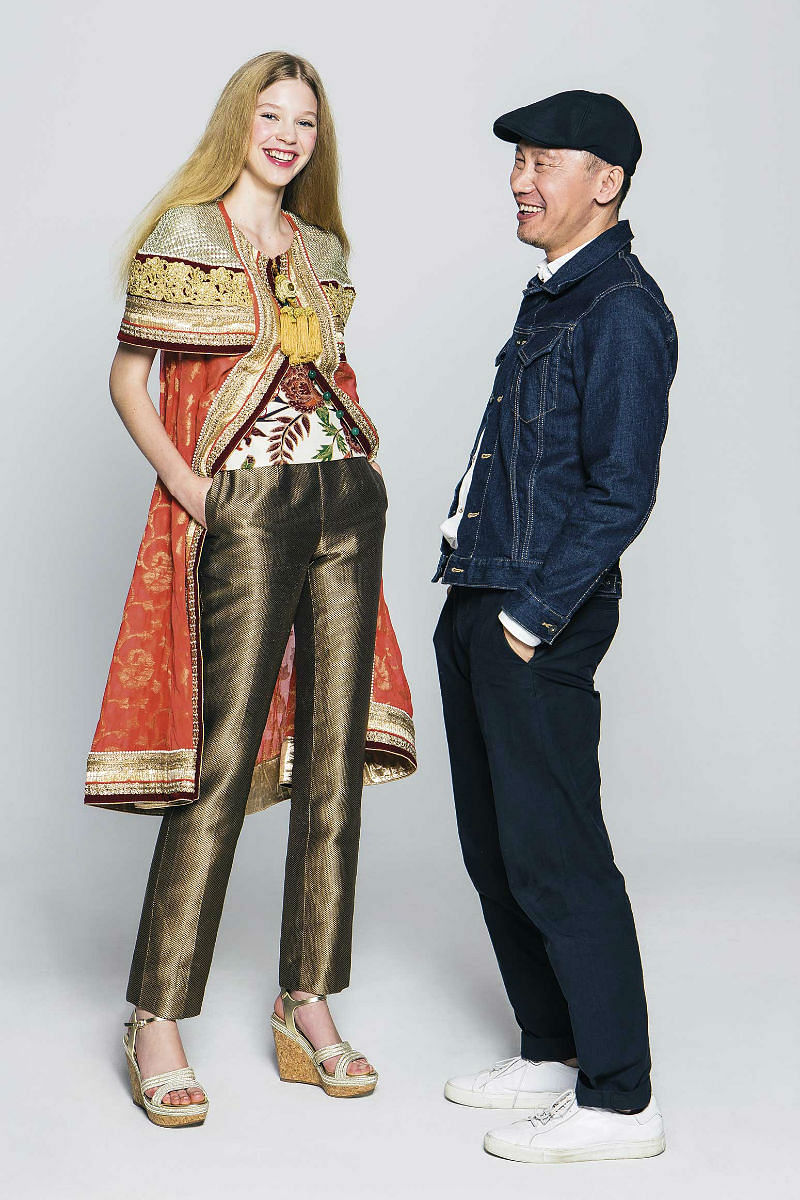
Photo: Zaphs Zhang
Lai Chan’s younger brother, Eddie, 51 was a welder for another brother of theirs who had a stainless steel business. Now he creates the brand’s accessories and intricate details.
He makes only one cheongsam from each print so his customers won’t run into someone else wearing the same thing
“Any print cheongsam you see on the racks is available in only one piece and one size. The idea is to protect my customers – because Singapore is so small, they might attend the same events in my cheongsams, and they are pretty distinctive.
I tell Hiroko that when she goes to Japan, no matter how attracted she is to a print, she should buy only enough for one piece, although it’s more costly.”
His foreign customers wear his cheongsams for proms and weddings
“I had a 16-year-old customer from the UK who bought a long cheongsam for her prom. I also have Japanese, Korean, Vietnamese, Chinese, and even Italian and French customers who buy lace cheongsams for their weddings. When they first came to me, they would wonder why my cheongsams were so expensive (a basic, off-the-rack one starts from $700). But they feel and see the difference once they put them on.
I also get wholesale requests from people from China who have worn my cheongsams. I always turn them down because I cannot cope with the production. In China, there is no shortage of cheongsam makers, but they know there is something different about my cheongsams, which is why they want to take them home to sell.
I recently had my first Kuwaiti customer. She saw my cheongsams in a magazine at the airport, came straight down to my shop, and bought one.”
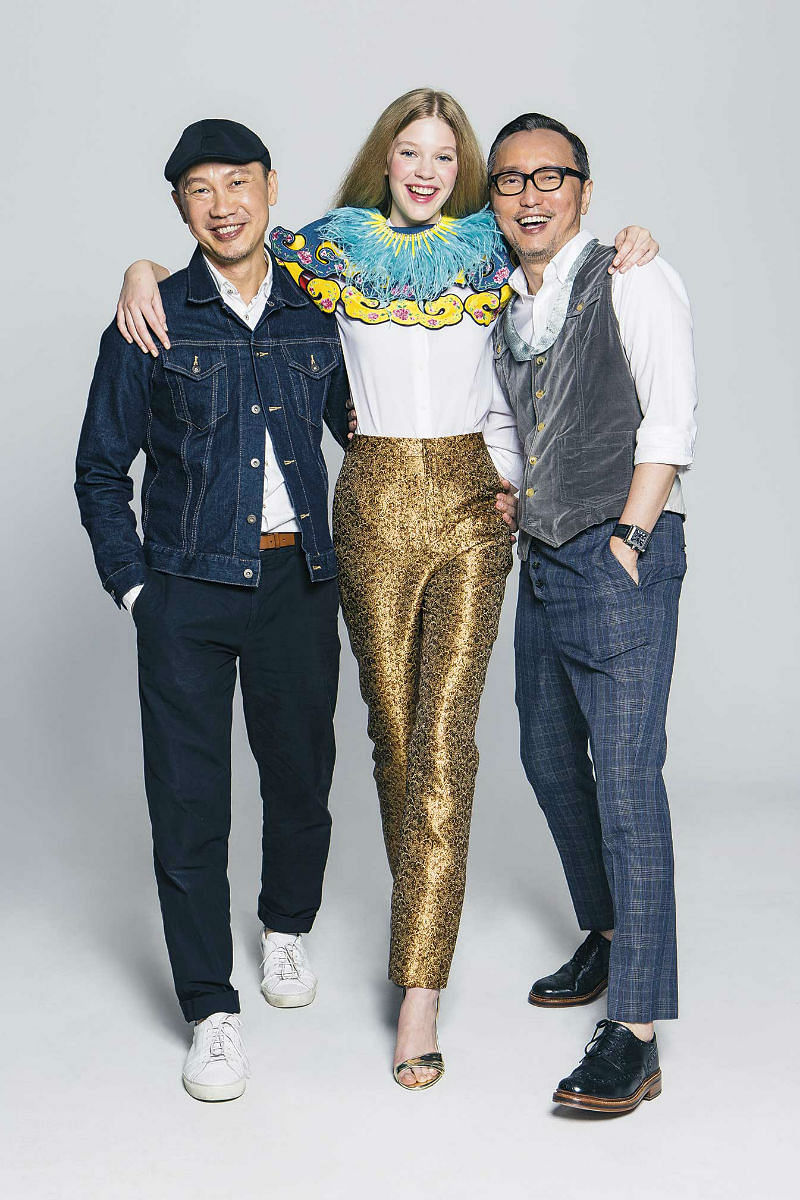
Photo: Zaphs Zhang
The cloud collar is Peranakan-inspired (which Lai Chan says is in turn inspired by Qing-dynasty fashions). He suggests wearing it with a T-shirt and teaming it with jeans or pants. “This is how you turn something traditional into something relevant and contemporary.”
His signature round buttons are made of semi-precious stones
“In the past, in China, commoners wore frog buttons while Chinese emperors wore buttons made of semi-precious stones – like turquoise or jade – on their imperial robes. So instead of zips or frog buttons, I thought it would be nice to incorporate an element of the emperor’s imperial robes into my cheongsams. We use semi-precious stones like agate, quartz, jade, and amethyst. For made-to-order cheongsams, we sometimes use freshwater pearls. All my classic cheongsams have a long row of buttons that runs from the collar to the hip, and you have to fasten them one by one. I like this detail because I think women should sometimes slow down a little and take time to enjoy the ritual of getting dressed.”
His customers are getting younger
“I think that there is a renewed interest in our roots and culture. I have customers who have grown up with me; I made their cheongsams and wedding dresses 25 years ago, and now I am doing the same for their daughters. My customers’ children are embracing the cheongsam. I get younger walk-in customers, and I also see young women who wear cheongsams daily. The age range of my customers has widened.”
THE SIGNATURES OF A LAICHAN CHEONGSAM
• It’s always bias-cut for the most flattering look, and to suit our modern lives.
• It is never lined; lining can ruin the line of the dress.
• Each off-the-rack piece has its own print. There are no duplicates.
• The buttons are made of semi-precious stones.
RECAP: SEE OUR FAVOURITE LOOKS FROM LAI CHAN’S SHOW AT SINGAPORE FASHION WEEK 2017
This story was first published in the January 2018 issue of Her World magazine.
Photography: Zaphs Zhang, assisted by Sherman See-Tho
Styling: Bryan Goh
Hair: Den Ng/Prep Luxe Salon
Makeup: Hongling Lim, assisted by Jane Lee, using Nars
Model: Nastya/Mannequin
Shoes: Aldo

